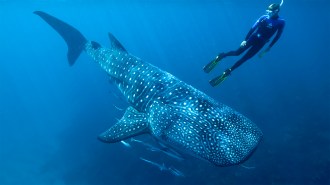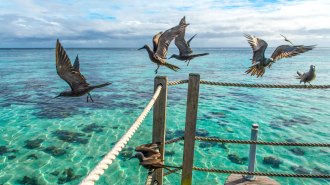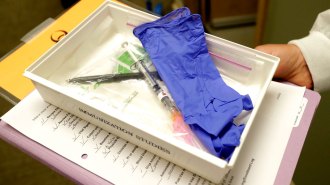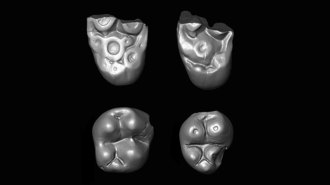Uncategorized
-
 Physics
PhysicsHere’s how the periodic table gets new elements
Today’s scientists keep adding to the periodic table. But an element has to earn its spot.
-
 Animals
AnimalsCold War nuclear test residue offers a clue to whale sharks’ ages
One unexpected legacy of the Cold War: Chemical traces of atomic bomb tests are helping scientists figure out whale shark ages.
-
 Astronomy
Astronomy‘Oumuamua might be a shard of a broken planet
A new origin story for the solar system’s first known interstellar visitor suggests it may have been part of a world that got shredded by its star.
-
 Math
MathTo cook a perfect steak, use math
As a steak cooks in an oven, movement of liquid within the meat causes it to become extra juicy in the center in a way that can be predicted by mathematics.
-
 Animals
AnimalsSeabirds may find food at sea by flying in a massive, kilometers-wide arc
Radar shows that seabird groups can fly together in giant “rake” formations. If they are cooperating to find food, it’s on a scale not yet seen in the birds.
By Jake Buehler -
 Environment
Environment50 years ago, American waterways were getting more protections
A 1970 bill that became the Clean Water Act helped to double the number of U.S. waterbodies clean enough for swimming and fishing. In January, the U.S. administration changed how waters were defined, effectively removing those protections for half the country’s wetlands.
-
 Health & Medicine
Health & MedicineWhy African-Americans may be especially vulnerable to COVID-19
African-Americans are more likely to die from COVID-19 than white Americans, data show. Experts blame long-standing health disparities.
By Sujata Gupta -
 Health & Medicine
Health & MedicineMeet Sophia Upshaw, a volunteer in a coronavirus vaccine trial
In Seattle and Atlanta, scientists have started testing the safety of a potential vaccine to prevent COVID-19.
-
 Science & Society
Science & SocietyHow materials science has changed humankind — for better and worse
As people began wielding new materials, the technologies fundamentally changed humankind, the new book ‘The Alchemy of Us’ argues.
-
 Physics
PhysicsA year after the first black hole image, the EHT has been stymied by the coronavirus
With this year’s observing run canceled due to the coronavirus, the Event Horizon Telescope team is analyzing data from 2017 and 2018.
-
 Health & Medicine
Health & MedicineCan fabric masks stem the coronavirus’ spread?
It’s unclear whether homemade masks made from fabric will prevent an infected person from spreading the virus to others, experts say.
-
 Paleontology
PaleontologyTwo primate lineages crossed the Atlantic millions of years ago
Peruvian primate fossils point to a second ocean crossing by a now-extinct group roughly 35 million to 32 million years ago.
By Bruce Bower